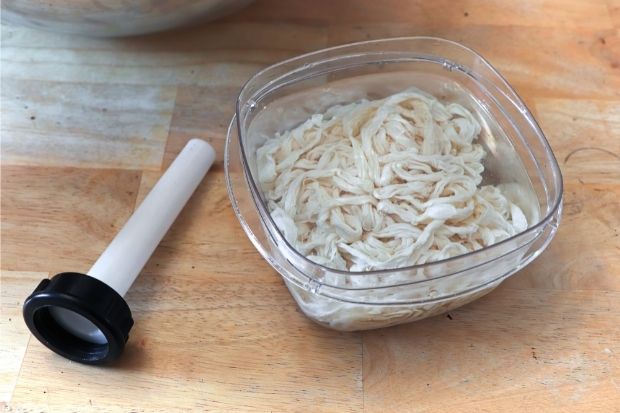If you want to make sausages at home, you have to learn how to take care of the casings first.
When you buy sausage casings, they come in a mixture that is mostly salt.
You must remove that salt before you make your sausages, and this usually involves soaking the casings before you do anything else.

How Long To Soak Sausage Casings
If you’re wondering how long to soak sausage casings, the amount of time will depend on the type of casing it is and where it comes from. That being said, you can count on soaking them for a minimum of 30 minutes, and sometimes overnight.
How Long Should You Soak Sausage Casings?
Before you learn how long to soak your casings, you should know how to care for them when you first buy them.
Casings need to be stored in a cool environment, such as in the refrigerator. The ideal temperature is between 41 and 50 degrees F. Once sausage casings get above 50 degrees F, they will start to diminish and they won’t last nearly as long. If stored properly, they can last up to one year. But they need to be kept away from heat and direct sunlight at all times. Again, keeping them in the fridge is a great idea.
You also have to thoroughly rinse all of the salt from the casings. You do this by soaking them in fresh water. It’s best to use warm water that is between 70-85 F. If the water is any warmer than this, it will be too warm and will promote bacteria growth and could also damage the casings themselves. It’s essential that you not use cool water or ice cold water, either. A nice warm temperature of 70-85 F is just right for soaking and cleaning sausage casings.
Soaking Time for Sausage Casings
As mentioned, it’s important to soak your sausage casings for the proper amount of time, not only to remove the salt but also to make sure they are easy to work with once you use a sausage stuffer to stuff the casings with sausage meat.
Here are some general guidelines for soaking your casings:
- Sheep casings: soak for a minimum of 45 minutes.
- Hog casings: soak for a minimum of two hours, preferably overnight.
- Beef casings: soak for a minimum of 12 hours.
If you use non-tubed casings, keep in mind that in addition to the soaking, you’ll also have to run a lot of fresh water through the insides of the casings so that you can eliminate any residual salt. The salt from casings needs to be eliminated as thoroughly as possible regardless of what type of casing it is, so that the sausage has the right taste and texture in the end.
It’s also good to know the different types of casings so that you can learn more about them. There are three main types of sausage casings:
- Natural casings. These are made from the intestines of a cow, sheep, or pig. They are sporadically shaped and become more resilient after they’re dried. The most common type of natural sausage casing is taken from a pig.
- Collagen casings. These come from natural products but are also a lot more processed. Also called fibrous casings, they are available in options such as fresh, processed, rounds, and middles. Fresh and processed casings are edible casings. Rounds and middles are inedible casings.
- Cellulose casings. These come from plant cell walls and are a popular choice for vegans. Cellulose casings can also be used by commercial manufacturers for the making of their “skinless” sausages.
Finally, in addition to soaking your casings, you should run plenty of warm water through them just to make sure you remove all of the salt on the inside and outside of the casings. If you decide later on that you don’t need as many casings as you thought, simply sprinkle some salt over the unneeded casings and put them back into the fridge, where they can remain for up to one year.

Why Sausage Casings Need To Be Soaked
Sausage casings are soaked for two main reasons: to remove all of the salt that is naturally there when you buy the casings, and to make sure the casings are pliable enough and therefore easy to work with once you start stuffing them.
What Happens if You Don’t Soak Sausage Casings Long Enough?
Simply put, your sausage casings will be a little stiffer than they should be and much harder to work with if they aren’t soaked for the proper amount of time. This is why it is crucial to keep your casings in the water for the right number of minutes or hours.
Water Temperature for Soaking Sausage Casings
The ideal temperature for soaking sausage casings is between 70-85 F. Any lower than 70 F and you won’t get the desired effect. Any higher than 85 F may result in bacteria forming somewhere on the casings, which could be very unsafe and dangerous.
Adding Vinegar When Soaking Sausage Casings
If you want your casings to be softer and more transparent, simply add one tablespoon of white vinegar to the bowl for every cup of water you just added. This is a trick used by professional sausage-makers. The vinegar does not give the casings a funny taste, but it goes a long way toward helping the overall look and texture of the casings you’re about to stuff with meat.
Now that you know how long to soak sausage casings, it’s time to learn how to tell if your sausage is cooked.
We also have a post on how to know if you are supposed to remove sausage casing before cooking or eating your sausage.
